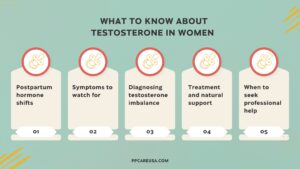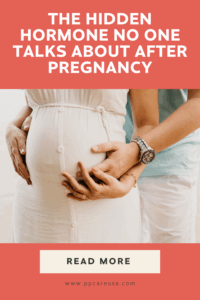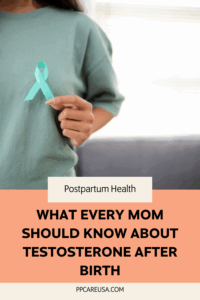Many postpartum women expect exhaustion, brain fog, or mood swings—but few realize that low testosterone in females could be part of the picture. Testosterone isn’t just a male hormone. It plays a critical role in energy, libido, mood, and muscle health for women too.
In the postpartum period, when hormones crash dramatically, testosterone levels for women can dip lower than optimal. Recognizing the symptoms of hormone imbalance and learning how to support your body naturally can be a game-changer for healing and recovery.
What is Testosterone & Why It Matters for Women
While testosterone is often labeled as the “male hormone,” women produce it as well—in the ovaries, adrenal glands, and with regulation from the pituitary gland.
Balanced testosterone levels for women support:
- Libido and sexual satisfaction
- Energy and motivation
- Muscle mass and bone strength
- Cognitive clarity and memory
- Emotional well-being
When these levels dip postpartum, the result can feel like hitting a wall—mentally, physically, and emotionally.
Postpartum Hormone Shifts & Testosterone Deficiency
After childbirth, women experience normal hormone crashes, including drops in estrogen, progesterone, and cortisol, which can significantly affect sex hormones. These hormonal shifts can lead to symptoms such as fatigue, mood changes, and low libido. Irregular periods can also be a sign of hormonal imbalance postpartum, reflecting disruptions in the menstrual cycle due to fluctuating hormone levels.
Testosterone deficiency in women refers to abnormally low levels of testosterone, which can occur in the context of postpartum depletion (
Source). Causes include nutrient depletion, chronic stress, and lack of sleep, all of which can further disrupt hormone production. Additionally, an underactive pituitary gland can contribute to low testosterone by disrupting hormone signaling between the brain and the adrenal glands.
Symptoms of Low Testosterone in Women
Low sexual desire is a common symptom of low testosterone in women, and these symptoms can affect overall well-being. Other hallmark signs include:
- Muscle weakness & loss of muscle mass
- Fatigue
- Low energy levels and fatigue
- Low libido, reduced libido, and low sexual desire
- Brain fog & depression
- Anxiety & irritability
- Sleep issues/insomnia
- Hair loss and thinning hair
For postpartum women, these symptoms can be especially confusing. Fatigue, mood swings, and hair loss are often brushed off as “normal” parts of new motherhood, when in reality they may signal deeper hormone imbalances.
Without proper testing, low testosterone can easily be mistaken for thyroid issues, postpartum depression, or simply the exhaustion of caring for a newborn.
Diagnosing Testosterone Imbalance in Women
Diagnosing a testosterone imbalance in women, especially low testosterone, can be a nuanced process. Many symptoms—like fatigue, muscle weakness, and decreased libido—overlap with other postpartum changes, making it easy to overlook the role of the primary male sex hormone, testosterone, in women’s health. Yet, testosterone plays a vital part in maintaining muscle mass, bone strength, and a healthy sex drive, so understanding your hormone levels is key to overall well-being.
Healthcare providers use a combination of tools to diagnose low testosterone. This typically starts with a thorough medical history and physical examination, where your provider will ask about symptoms such as decreased sex drive, muscle weakness, changes in hair growth, and even mood shifts.
Since testosterone levels in premenopausal women fluctuate throughout the menstrual cycle, the timing of a blood test is important for accurate results. For postmenopausal women, testosterone levels tend to be more stable, but the drop in estrogen can also impact testosterone production.
The adrenal glands, which produce certain hormones and a significant portion of testosterone in women, can be affected by conditions like adrenal insufficiency, leading to lower testosterone levels. Surgical menopause, surgical removal of the ovaries, and certain medications can also disrupt hormone levels and contribute to symptoms of low testosterone, such as hypoactive sexual desire disorder, sexual dysfunction, and decreased sex drive.
To diagnose low testosterone, your healthcare provider may order a blood test to measure testosterone levels and other hormones. While the normal range for testosterone in women can vary, levels below 15 ng/dL are often considered low. However, diagnosis isn’t based on numbers alone—your symptoms and overall health are just as important. For example, androgen deficiency can present with vague symptoms, so a holistic approach is essential.
Treatment of Low Testosterone in Women
If low testosterone is confirmed, your provider will work with you to identify possible causes, such as adrenal insufficiency or the effects of certain medications. Treatment options may include testosterone therapy, hormone therapy, or testosterone supplements, but these should be carefully monitored to avoid side effects like facial hair, acne, or an enlarged clitoris from too much testosterone. Lifestyle changes, such as regular physical activity and a balanced diet, can also support healthy hormone levels and muscle health.
Ultimately, diagnosing and treating low testosterone in women is a collaborative process. By working closely with your healthcare provider, you can develop a personalized plan to restore hormone balance, improve muscle strength, and support your overall health—empowering you to feel your best during the postpartum period and beyond.
High Testosterone in Females: The Other Side of the Spectrum
While many postpartum women struggle with too little testosterone, some experience the opposite.
High testosterone in females can show up as:
- Oily skin and acne
- Irritability and mood swings
- Abnormal or excess hair growth
- Irregular cycles
This imbalance is sometimes connected to PCOS, insulin resistance, or adrenal dysfunction. Just like low testosterone, it can create its own set of challenges postpartum.
How to Increase Testosterone Naturally Postpartum
The good news is that lifestyle, nutrition, and stress management can go a long way in balancing testosterone levels. Here are some ways to increase testosterone naturally:
- Prioritize protein: Aim for 30g per meal to support muscle and hormone health.
- Include healthy fats: Avocados, olive oil, and grass-fed butter provide the building blocks for hormone production.
- Add cholesterol-rich foods: Grass-fed butter and eggs help create sex hormones.
- Focus on gut health: Fermented foods and fiber aid in detoxifying excess hormones.
- Replenish micronutrients: Zinc, magnesium, vitamin D, and B vitamins are crucial for hormone function.
- Incorporate strength training: Light weight lifting or resistance exercises help preserve muscle and encourage hormone balance.
- Reduce stress: Cortisol steals resources from sex hormones. Gentle routines like yoga, walking, and meditation can help restore balance.
If natural strategies aren’t enough for treating low testosterone, your provider may discuss medical options like hormone therapy or testosterone supplements. These should always be personalized and carefully monitored.
When to Seek Professional Support for Symptoms of Low Testosterone
If fatigue, low libido, or mood swings are interfering with daily life, it’s time to dig deeper. Hormone imbalance is common after birth, but it’s not something you have to live with.
Ask your provider for a full lab panel that includes testosterone, thyroid hormones, cortisol, and nutrient markers. A physical exam and comprehensive history are also key.
At Postpartum Care USA, we work with women to identify the root causes of low testosterone and other hormonal imbalances—offering lab-based care based on a unique blood test, personalized supplement plans, and strategies that restore energy and confidence.
Conclusion
Hormone imbalances are common but treatable, and it’s important to remember that women, deserve more than a simple “you’re fine” when experiencing symptoms.
If you are a post menopausal woman or have had your ovaries removed, you may be at higher risk for low testosterone.
It’s important to discuss your symptoms and options with a healthcare provider, as these factors can significantly impact hormone levels.
Ongoing research is evaluating the long-term safety of testosterone therapy, including its effects on breast cancer risk and breast health, especially in postmenopausal women.
Book a
postpartum consult or explore lab-based care to take charge of your hormonal health.
FAQs About Low Testosterone in Women
What are the signs of low testosterone levels in females?
The most common signs of low testosterone in women include fatigue, muscle weakness, low libido, brain fog, hair loss, sleep disturbances, and mood changes like anxiety or depression. These symptoms are especially common postpartum and can easily be mistaken for normal recovery or other conditions such as thyroid imbalance.
How can a woman increase her testosterone levels?
Women can naturally increase testosterone levels by prioritizing protein and healthy fats in their diet, replenishing micronutrients like zinc, vitamin D, and magnesium, and incorporating strength training or resistance exercise. Stress management is also key, since high cortisol can suppress sex hormones. In some cases, a healthcare provider may recommend hormone therapy or supplements, but these should be monitored closely to avoid side effects.
Does low testosterone in women cause weight gain?
Yes, it can. Low testosterone levels in females often leads to reduced muscle mass, which lowers metabolism and makes it easier to gain weight—particularly around the midsection. Hormone imbalance can also increase fatigue and decrease motivation to exercise, creating a cycle that makes weight management more difficult.
What are the warning signs of low testosterone?
Warning signs of low testosterone levels include persistent fatigue, unexplained mood changes, difficulty concentrating, decreased libido, loss of muscle tone, and thinning hair. If these symptoms continue for months after giving birth, or if they affect daily life, it’s important to ask your provider for a full hormone panel to rule out testosterone deficiency in women and other hormone imbalances.
Pin This for Later:





Get in touch